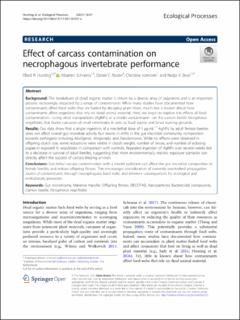| dc.contributor.author | Hunting, Ellard R. | |
| dc.contributor.author | Schrama, M | |
| dc.contributor.author | Rozen, Daniel E. | |
| dc.contributor.author | Joenssen, Christina | |
| dc.contributor.author | Brun, Nadja Rebecca | |
| dc.date.accessioned | 2022-04-07T11:49:22Z | |
| dc.date.available | 2022-04-07T11:49:22Z | |
| dc.date.created | 2022-02-01T09:14:20Z | |
| dc.date.issued | 2021 | |
| dc.identifier.issn | 2192-1709 | |
| dc.identifier.uri | https://hdl.handle.net/11250/2990526 | |
| dc.description.abstract | Background
The breakdown of dead organic matter is driven by a diverse array of organisms and is an important process increasingly impacted by a range of contaminants. While many studies have documented how contaminants affect food webs that are fueled by decaying plant litters, much less is known about how contaminants affect organisms that rely on dead animal material. Here, we begin to explore the effects of food contamination—using silver nanoparticles (AgNPs) as a model contaminant—on the carrion beetle Nicrophorus vespilloides that buries carcasses of small vertebrates in soils as food source and larval nursing grounds.
Results
Our data show that a single ingestion of a non-lethal dose of 1 μg mL−1 AgNPs by adult female beetles does not affect overall gut microbial activity but results in shifts in the gut microbial community composition towards pathogens including Alcaligenes, Morganella, and Pseudomonas. While no effects were observed in offspring clutch size, some reductions were visible in clutch weight, number of larvae, and number of eclosing pupae in exposed N. vespilloides in comparison with controls. Repeated ingestion of AgNPs over several weeks led to a decrease in survival of adult beetles, suggesting that more environmentally realistic exposure scenarios can directly affect the success of carcass-feeding animals.
Conclusions
Sub-lethal carcass contamination with a model pollutant can affect the gut microbial composition in female beetles and reduce offspring fitness. This encourages consideration of currently overlooked propagation routes of contaminants through necrophagous food webs and inherent consequences for ecological and evolutionary processes. | en_US |
| dc.language.iso | eng | en_US |
| dc.publisher | Springer | en_US |
| dc.rights | Navngivelse 4.0 Internasjonal | * |
| dc.rights.uri | http://creativecommons.org/licenses/by/4.0/deed.no | * |
| dc.title | Effect of carcass contamination on necrophagous invertebrate performance | en_US |
| dc.type | Journal article | en_US |
| dc.type | Peer reviewed | en_US |
| dc.description.version | publishedVersion | en_US |
| dc.rights.holder | Copyright 2021 The Author(s) | en_US |
| dc.source.articlenumber | 57 | en_US |
| cristin.ispublished | true | |
| cristin.fulltext | original | |
| cristin.qualitycode | 1 | |
| dc.identifier.doi | 10.1186/s13717-021-00327-z | |
| dc.identifier.cristin | 1996006 | |
| dc.source.journal | Ecological Processes | en_US |
| dc.identifier.citation | Ecological Processes. 2021, 10, 57. | en_US |
| dc.source.volume | 10 | en_US |

